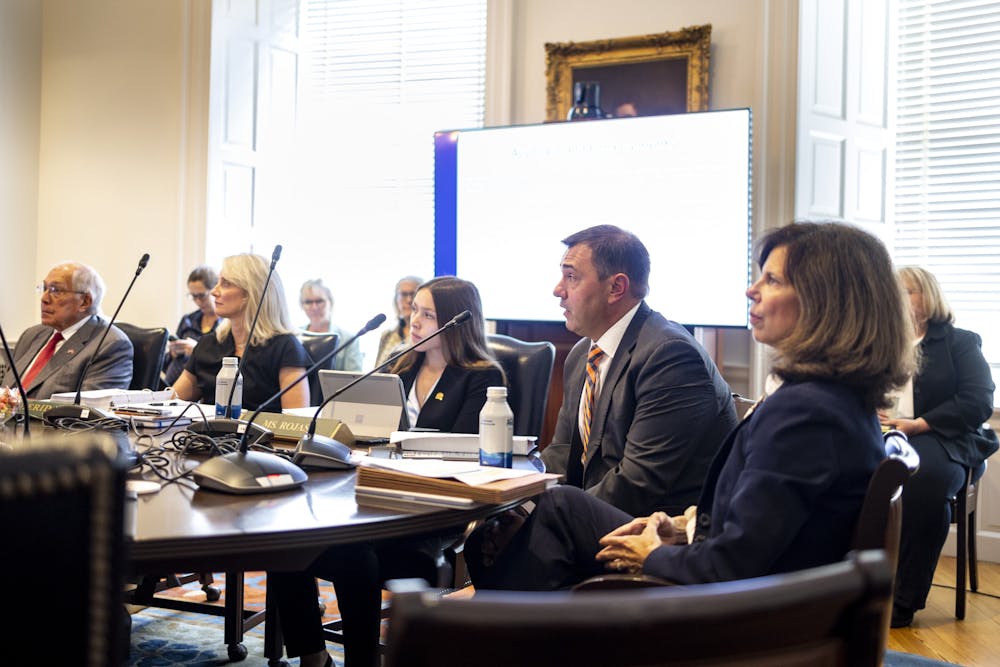The Board of Visitors’ Buildings and Grounds Committee approved a new Scott Stadium video scoreboard and heard updates on the renovation of Alderman Library during their meeting Thursday. The Board also approved the naming of two new upper-class residence halls in honor of former professors, as well as the addition of new extensions at Fontaine Research Park.
University architect Alice J. Raucher said that the new scoreboard at Scott Stadium will be 54 feet tall and 125 feet wide. The scoreboard currently stands 21 feet tall and 28 feet wide, making it the second smallest scoreboard in the ACC, second only to Boston College.
“The proposed video board will… place us in the top three for the ACC with Clemson and Florida State,” Raucher said.
The current scoreboard at Scott Stadium now — installed in 2009 — is outdated and requires many repairs annually. The age of the scoreboard also makes it difficult to order replacement parts.
Additionally, installing the new scoreboard will require replacing the entire video scoreboard and stadium sound system. The design team was headed by VDMO Architects, and the project aims to provide an improved audio-visual performance for the 2024 football season.
In addition to approving the new scoreboard, Colette Sheehy, senior vice president for operations and state government relations, provided an update on the Alderman Library renovation project and said that she was hopeful that the library would be reopened for students after Thanksgiving break.
Since the last update on the project was provided at the Committee’s meeting in March, the scaffolding has been removed from the exterior of the library. Sheehy said that while the library would be open, fully moving the books back into the space will take an estimated six months.
The storage within the library has been shifted from storage stacks to a higher density storage. According to Sheehy, this will ensure that less square footage is taken for storage of books, and many titles will remain in a storage facility.
Sheehy also discussed the renovations on McCormick Road in front of the McCormick residence halls, which were conducted over the summer. The sidewalks on the road were widened and the travel lanes were narrowed, which Sheehy said was designed to slow down traffic and emphasize the road’s pedestrian focus.
“Students were walking out into the street during class change times because there was so much traffic in this corridor here.” Sheehy said. “This is a really big improvement.”
Other projects discussed included the two upper-class residence halls currently under construction on Brandon Avenue, close to Bond House and the Student Health and Wellness Center.
The Committee voted to name the buildings Gaston House and Ramazani House after former University professors, Paul M. Gaston and Rouhoullah “Ruhi” Ramazani, both of whom taught at the University for more than 30 years. Per University naming policies, residence halls are typically named for longtime faculty members deemed to have been effective teachers.
Each of the residence halls will have approximately 350 beds and 100 parking spots, as well as a dining facility shared between them. The two buildings are expected to be completed by Fall 2024.
The new residence halls upperclassmen as the University moves toward its goal of requiring all first and second year students to live on Grounds. The requirement is an important part of the University’s 2030 plan — a set of goals for the University that focus on a variety of long-term projects.
The committee also approved plans for several expansions at Fontaine Research Park, including a new energy plant and biotechnology facility. These additions are part of a larger plan for additions to the park, which include sidewalks and bike lanes.
“Part of our focus has always been to increase transit and pedestrian connectivity to the Park,” Raucher said.
The Building and Grounds Committee will convene again during the December meetings for the Board of Visitors.







